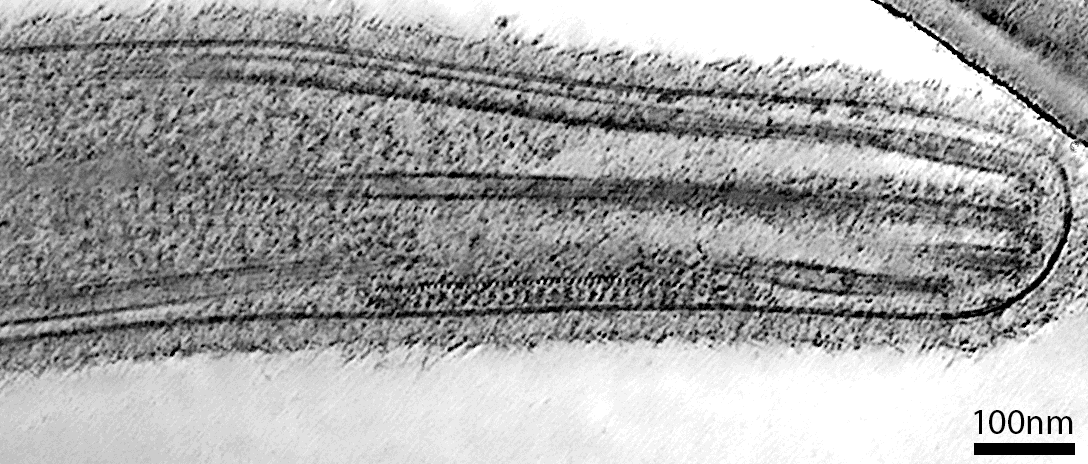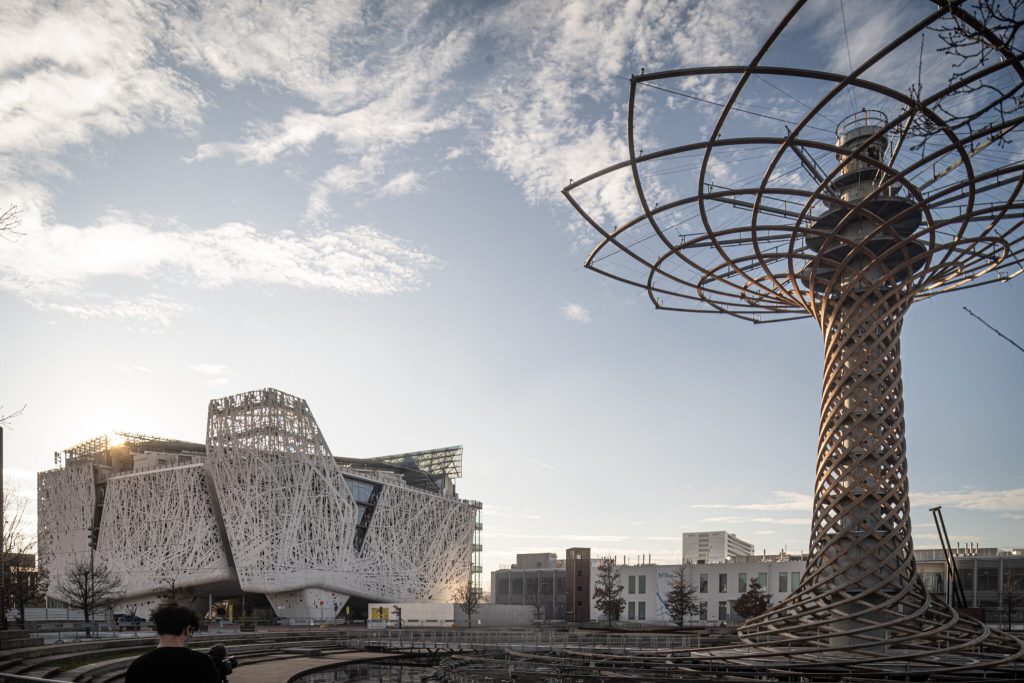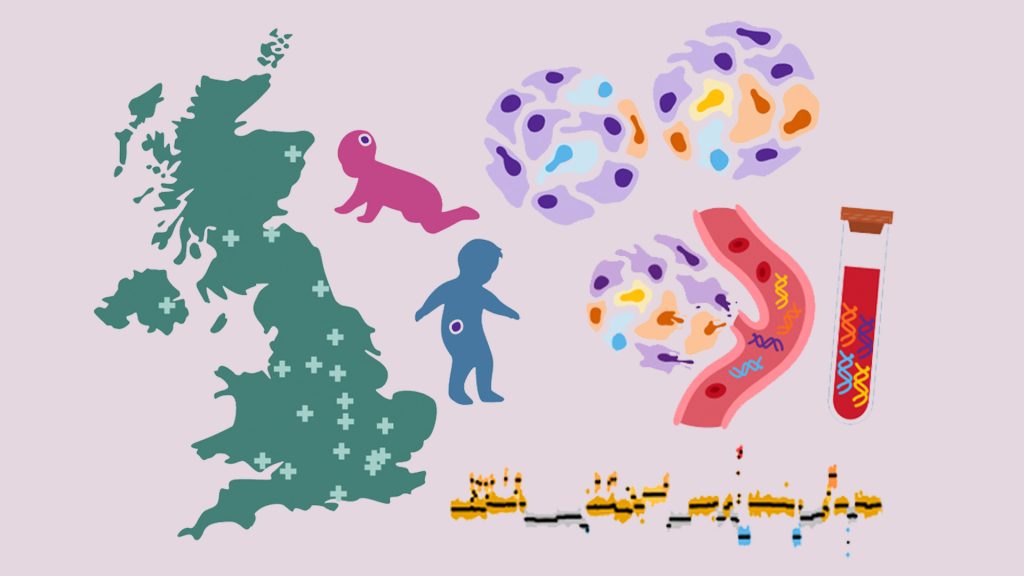Derailing molecular cargo trains in cilia makes them turn around

Researchers at the Human Technopole and Max Planck Institute of Molecular Cell Biology and Genetics show how molecular cargo trains change direction in cellular micro-antennas.
Cilia are antenna-like structures that protrude outwards from the surface of eukaryotic cells. Misassembled cilia in humans can cause numerous diseases from infertility to lung malfunction. The assembly and maintenance of cilia requires a bidirectional transport machinery known as Intraflagellar Transport (IFT), which moves in train-like structures along the microtubular skeleton of the cilium. IFT trains move from the cell to the ciliary tip to deliver cargoes that maintain the assembly of the cilium. They then turn around and return to the cell at high speed. Because of this, it has long been assumed that a special molecular machinery at the ciliary tip is necessary for the trains to turnaround. The research group of Dr. Gaia Pigino, at the Human Technopole Structural Biology Research Centre in Milan, has now shown that the ability to turn around is an intrinsic property of IFT trains that can happen all along the cilium without any dedicated stationary tip machinery being required. These findings have been published in the journal Current Biology.
Cells need to be able to sense different types of signals, such as chemical and mechanical signals, from the environment to properly function. Most eukaryotic cells perform these functions through a specialised hair-like organelle, the cilium, that extends from the cell body as a sort of antenna. We smell through olfactory sensory cilia in our nose, we see through the photoreceptor cilia in our eyes and we hear thanks to kinocilia in our ears. Other cilia move in a beating fashion that for example allow us to breathe by keeping the lungs clean, or they allow us to reproduce by propelling sperm cells, and even to properly reason, because they contribute to the flow of fluids in the brain. Not surprisingly, defects in the assembly and function of these tiny organelles result in serious diseases, which are collectively known as ciliopathies. Thus, proper function of cilia is fundamental for human health.
A method to interfere with IFT trains
A bidirectional molecular transport system known as intraflagellar transport (IFT) is required for the proper assembly and function of cilia. IFT trains are propelled from the cell to the ciliary tip (anterograde direction) by kinesin-II motor proteins, where they unload the cargo needed for the assembly of the cilium before turning around and moving back to the cell (retrograde direction) driven by dynein motor proteins. The mechanism that coordinates the disassembly and reassembly of the IFT trains, which allows them to turn around, is unknown. It is commonly assumed that large protein complexes observed at the ciliary tip are responsible for this conversion of the IFT trains. Adrian Nievergelt, a postdoctoral researcher in the Pigino group, at the Max Planck Institute of Molecular Cell Biology and Genetics, jointly with Ludek Stepaneck, former postdoc in the same team, have now developed a method to mechanically manipulate and stall IFT trains inside the cilia of the green alga Chlamydomonas at defined positions along the cilium. By observing the behaviour of these trains in a fluorescence microscope, they showed that such trains can readily change direction even at distance from the ciliary tip.
The researchers noticed that the IFT trains which convert and turn around at the tip do so slightly faster than when they get artificially stalled at any other spot. This brought up the question: is there a mechanistic difference between the two situations? In search of an answer, the group turned to cryo electron microscopy, a Nobel prize winning technology that uses high energy electrons to capture greatly magnified images of biological structures and reconstruct three dimensional tomographic representations at atomic resolution. These reconstructions of the cilia are noisy and hard for human eyes to interpret. Tim-Oliver Buchholz, a former member of the group of Florian Jug, now at the Human Technopole Computational Biology Research Centre, applied his method cryo-CARE, a specifically trained neural network, to remove noise from the cryo-tomographic data. In one of the reconstructions, the scientists observed an exciting rare event of an IFT train in the process of walking off its rail at the flagellar tip. Adrian Nievergelt elaborates: “It was a revealing experience: once the noise was removed from the tomographic data, we could easily see how the very regularly structured IFT train falls apart and dissolves right after it passes the end of the microtubule it was running on.”
“It is striking how we can never observe an IFT train that changes direction twice. An explanation for this in Chlamydomonas is that the kinesin motors are no longer present on retrograde trains.” elaborates Gaia Pigino and concludes: “This discovery is an important step to solving the molecular mechanisms of how IFT trains convert in the cilium.”
https://authors.elsevier.com/sd/article/S0960-9822(22)01160-5
Image: Cryo electron tomography of an intraflagellar transport train leaving the microtubule rail at the ciliary tip.
Total internal reflection microscopy of the cilia of cells of the alga Chlamydomonas, showing fluorescent intraflagellar transport trains moving up and down the cilia.




